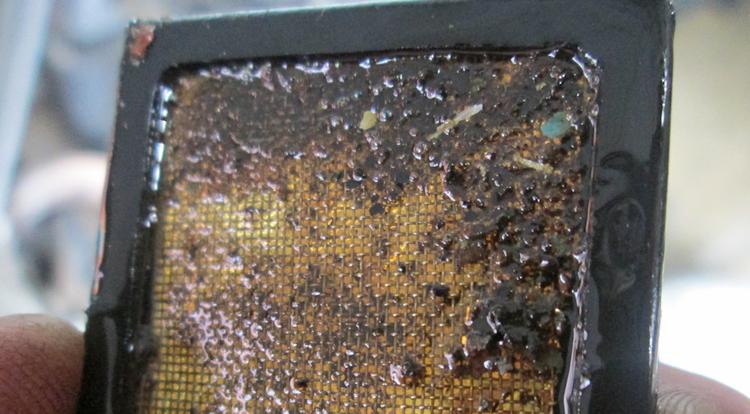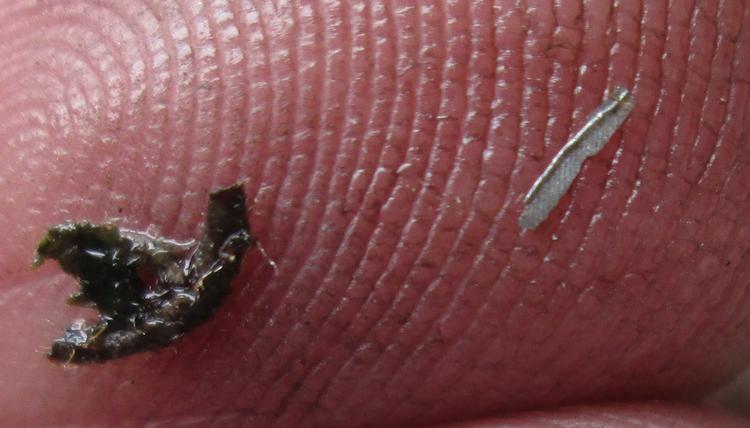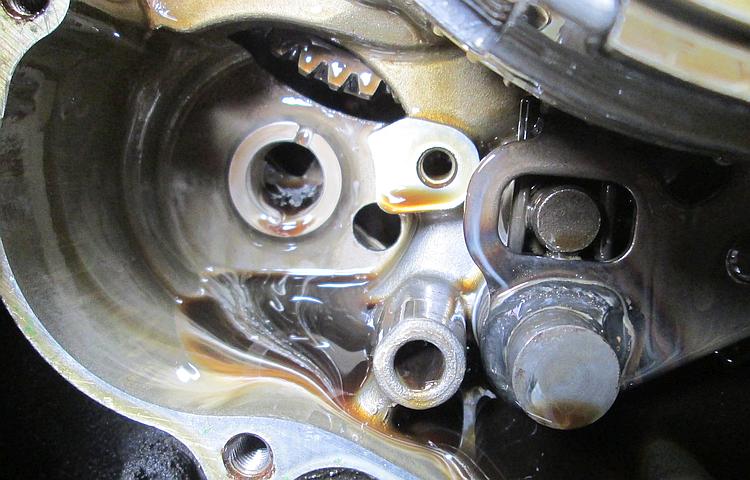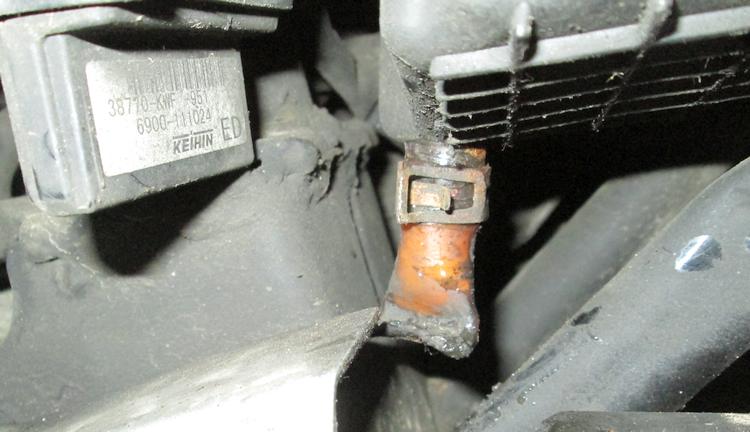Home
Repair And Restoration
Metal And Water In Oil
Work Date - 02 March 2016
By Ren Withnell
My CBF 125 is now at 50,000 miles.
Haynes, following Honda's service schedule, recommend the motorcycle is serviced every 2,500 miles. The engine part of the service should include...
1. Tappet adjustment
2. Oil change
3. Sump filter gauze clean
4. Centrifugal filter clean
Ever since purchasing the bike with 5,700 miles on the clock I have changed the oil religiously every 2,000 miles, more than recommended. After initial errors I was much more diligent with the tappets, checking them every 4,000 miles. At 20,000 miles I had to replace the clutch basket and after that I reduced checking the tappets to every 10,000 miles as they seemed to have settled in and rarely went out of spec.
The more observant among you will notice I make no mention of checking the sump filter gauze or the centrifugal filter. While replacing the clutch basket these items were cleaned and only minimum contamination was found. I promised myself I'd check these every 10,000 miles along with the tappets but laziness and a firm belief that changing the oil regularly was enough meant I never bothered. So the last time I was inside the crankcases was 30,000 miles ago.
I think a 125 achieving the 50,000 miles mark is impressive. As a special treat I splashed out on a new clutch cover gasket and took it upon myself to actually inspect and clean the gauze filter and the centrifugal filter. I'm glad I did because I know I should, but I wish I hadn't.
Having copper slipped the crankcase bolts before replacing them all those miles ago I was pleased every bolt came out smoothly and cleanly. I was even more pleased I had greased the gasket when I fitted it as the gasket came off with the crankcase cover completely intact. I was rather displeased to find the small gauze filter in the sump covered in gunk and a few small bits of metal. Oh dear.
 Oh dear..what are them metallic bits?
Oh dear..what are them metallic bits?
What does this mean? I do not know. The sludgy gunk is to be expected I suppose. A high revving and hard working little engine will in 30,000 miles be expected to have carbon deposits, burnt oil deposits, the odd foreign body and general snotty bits. It's the bits of metal that concern me. Before I go on let me show you some examples.
 My finger give you an idea of the size
My finger give you an idea of the size
 Can you tell me what they are?
Can you tell me what they are?
What are they and where are they from? 1 or 2 pieces look like "white metal" which is typically found on bearings. GULP! Whoa, hang on a moment...only plain bearings with shells have white metal don't they? And the 125 has roller bearings doesn't it? Let me check Honda's drawings online... Pressed crank with a 1 piece conrod usually means needle roller bearings. Definitely roller bearings on the mains. Roller bearings on the gearbox shafts. Plain bearings in the head but without shells. I can't see anywhere likely to have white metal shelled plain bearings.
Could they be from the gears? Could they be bits of piston ring? The clutch? I have absolutely no idea. Please, if you're reading this and you have any thoughts or opinions then please let me know in the comments below. I...I might regret asking that.
Within the centrifugal filter was found a small amount of compressed sludge that was easy to wipe away with a rag. There were no more pieces of metal and nothing untoward here, in fact I was surprised at how clean this filter was.
 There's a little gunk but nothing untoward in the centrifuge.
There's a little gunk but nothing untoward in the centrifuge.
Then there's the oil. At the last change (48,000) I noticed just a touch of milky oil as the last of the oil drained out, only a bit. This was unusual but I had been riding a lot through the floods and tsunamis of this wet winter so I figured perhaps a little condensation and a touch of ingestion had contaminated the oil. With the crankcase off I observed perhaps more emulsified oil than I would like to have seen or would expect from condensation. Now what?!
 It's not a whiteout but more than I was comfortable seeing.
It's not a whiteout but more than I was comfortable seeing.
There's no oil leaks on this engine. As such if the oil is not escaping under the pressure of the crankcase then it's hard to believe the water is getting in. I'll have to do some more research. I clean out the creamy oil, clean and replace the filters, re-grease the gasket, re-copper-slip the bolts and put everything back together. I fill her up with fresh oil and call it a day.
Later that evening I Googled "Oil Emulsification Air Cooled Engine". Suggestions range from condensation to filler cap leaks. Condensation is unlikely as the bike rarely covers less than 5 miles on a journey, typically they're between 15 and 150 miles. Several people noted that cracked crankcase breather pipework could be the problem. I duly went outside and inspected my breather to find it in perfect condition and snugly fitted. It's not that. Other ideas included water in the airbox. Pfffft - silly - erm...don't airboxes have them crappy little blocked off pipes? Yeah...I remember now...you're supposed to unplug them or remove them once in a while to let any water out of the airbox.
 I mean really, whoever actually checks these bloody things.
I mean really, whoever actually checks these bloody things.
Naaaah. In 25 years I've only ever checked them occasionally and each time a tiny little pathetic dribble came out. Well, while I'm here eh. I find the little stubby bit of pipe, wrestle the clip away with my pliers and with some effort remove it. I am met with a small river of horrible milky water. I estimate about a large teacup of water comes out - sufficient to fill the bottom of the airbox and enough to reach the level of the crankcase breather pipe. I think I've found my problem.
How does the water get in there? 2 ideas. Firstly as the engine warms up the condensation is heated off and presumably the steam makes its way into the airbox via the crankcase breather pipe. There in the cooler air it condenses back into water. Secondly while the air intake is well hidden and protected beneath the seat I reckon some spray and mist will be sucked in. That which is not drawn through the engine will settle at the bottom of the airbox. However it gets in there it needs to be drained off.
Lesson learned - the hard way. Now, about those bits of metal...
Reader's Comments
Bob said :-
Your emulsified oil is probably just the result of condensation, as was the water in the air box. If you've never drained it before, riding in all weathers as you do it's distinctly feasible. Other than that, as you say riding in persistent rain frequently is bound to result in moisture build up.
The gauze screen doesn't look bad for 50000 miles, I've seen far far worse.
Those bits of metal - why did you need to replace the clutch basket? Could it be bits of that?
Otherwise a slack camchain can saw bits of alloy off the inside of the camchain tunnel. Does the cam run in bearings or direct in the head (another potential source of soft metal).
My favourite would be bits of gear pinion, given that they look very jagged.
03/03/2016 13:18:23 UTC
Ren - The Ed said :-
You've seen far worse! Eeeew yuk I was shocked to see that much gunk. I wasw hoping to find a small piece of fluff that's all. I guess I expect too much.
The camchain doesn't rattle so I'm hoping it's not slack. The cam runs direct in the head. When I check the tappets I'll inspect the faces to see what condition they're in. I hope you're right about bits of gears...I can live with that.
The basket was replaced due to a knocking from it. I'll add the link...
www.bikesandtravels.com/biker.aspx?ride=587...
03/03/2016 17:36:12 UTC
Bob said :-
There's a bit of gasket paper in there - that could have been from when you changed the clutch.
If the gauze has never been cleaned, some of that stuff could have been in there from new.
It's really not that bad, don't worry about it.
08/03/2016 08:57:57 UTC
Ren - The Ed said :-
I'll take comfort from your words Bob. At 50,000 miles I am starting to wonder just how long the engine can last. I wonder if Honda would give me a medal if I got it up to 100,000 miles?
08/03/2016 14:44:28 UTC
Bob said :-
50,000 is very impressive - a testament to Honda's design and build and your care of it.
There was that story about Volvo offering a million dollars or so to the guy in the USA who'd done a million miles in his Volvo, which he'd owned from new - you never know!
But, that said I'd be thinking about picking up a spare engine, though I am paranoid about such things so I'm not be the best person to ask. I have spare engines for all my bikes (more than one in some cases).
It's not necessarily to cover the "expected" engine life either, I had a BMW F650 Funduro, a bike well known for being capable of high mileages, but the gearbox output bearing failed at 25000 miles. That's not the end of the world but splitting one of those engines is a big job and requires a number of special pullers, so it was easier to drop in a spare engine.
09/03/2016 10:13:55 UTC
Name
Comment
Add a RELEVANT link (not required)
Upload an image (not required) -
Uploading...
Home
Repair And Restoration